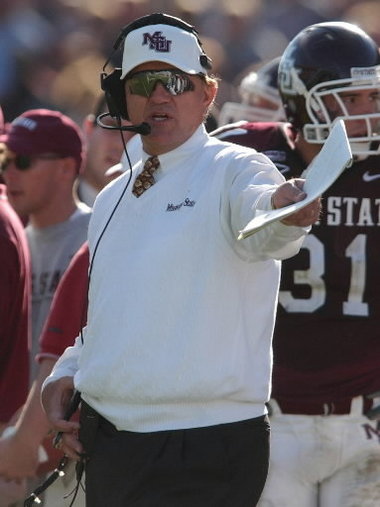Jackie Sherrill proud to be going into Mississippi shrine
Posted on: July 24,2016

Jackie Sherrill remains the only football coach to take a Mississippi team to the SEC Championship Game.
This is the second of a series of stories about the Mississippi Sports Hall of Fame’s inductees for the Class of 2016.

Rick Cleveland
Jackie Sherrill was born in Duncan, Okla., but he spent his formative years in Biloxi and, much later, coached the Mississippi State football Bulldogs for 13 seasons. He knows much about the Magnolia State’s storied sports history.
And that’s why it means so much for him to be inducted into the Mississippi Sports Hall of Fame.
“When you look at the athletes this small state has produced, it’s just amazing,” Sherrill said. “Some of the greatest athletes, including football players, in the history of the world are from Mississippi. To go into this Hall of Fame means something.”
Sherrill was a high school All American football player at Biloxi, before signing to play for Bear Bryant at Alabama. He helped the Crimson Tide win two national championships, then stayed on to work for Bryant as a graduate assistant.
That was the start of a 37-year coaching career, including head coaching stops at Washington State, Pittsburgh, Texas A & M and State.
His greatest success probably came during his five years at Pitt, where his teams won 50 games, while losing only 9 and where he coached such football legends as Dan Marino, Tony Dorsett, Hugh Green and Rickey Jackson.
Said Dorsett, who came to Jackson for a roast of Sherrill in 2014: “I went to him as a boy. I left as a man. He really was more than a football coach to me.”
Sherrill’s Pitt teams (1977-81) were all nationally ranked and finished as high as No. 2 in the nation. In 1981, he was named the Walter Camp National Coach of the year.
At Texas A & M (1982-88), Sherrill’s teams again were remarkably successful, winning 52 and losing 28 and winning three consecutive conference championships and two Cotton Bowls.
In 1991, Sherrill came out of retirement to accept the challenge of coaching Mississippi State. He took over a program that had experienced only one winning season in its previous nine.
Sherrill led the Bulldogs to seven victories and bowl berths in his first two seasons. He served notice that State football was back in only his second game when State knocked off No. 13 Texas 13-6 at Scott Field.
Success on the field led to success at the turnstiles and eventually to expansion of Scott Field, where Sherrill’s MSU teams played to over 90 percent of capacity during his tenure.
Sherrill has credited his predecessor Rockey Felker for leaving the program in good shape, especially from a talent standpoint.
“People don’t understand how close Rockey was,” Sherrill has said. “We had good players. Those players just needed some confidence to get over the hump.”
The victory over Texas surely helped. So did later wins that first season over Auburn, LSU and Ole Miss. That confidence was solidified in 1992 when the Bulldogs won at Texas, defeated Auburn again, hammered No. 13 Florida and also defeated Arkansas.
Said Sleepy Robinson, the quarterback of those Bulldogs, “Jackie Sherrill was the best motivator I have ever been around. He could get you motivated to do anything.”
During Sherrill’s tenure, the Bulldogs won three straight games over his alma mater, Alabama, at one point. When his team defeated the Crimson Tide 29-7 on Nov. 11, 2000, Sherrill became to that point the winningest coach in Mississippi State history.
Perhaps his biggest achievement at State: In 1998, the Bulldogs won the SEC Western Division title. Headed into the 2016 season, Sherrill remains the only Mississippi coach to take a team to the SEC Championship Game.
Sherrill finished his State tenure with a 75-75-2 record. His overall record as a college head coach was 180-120-4. In all, his teams played in 14 bowl games, winning eight.
•••
To purchase tickets to the BancorpSouth Induction Weekend festivities, call 601 982-8264 or click here and follow the links.
•••
Read Rick Cleveland’s Mississippi Today column about Gov. William Winter winning The Rube Award for his lifetime contributions to Mississippi sports.



